7-1 Dynamic atmospheres of Jupiter and Saturn change rapidly
 Go to Video 7-1
Go to Video 7-1
Jupiter and Saturn are, respectively, the largest and second largest of our Sun’s planets, and by far the largest objects in the solar system other than the Sun itself. Astronomers have known for centuries about the huge diameters and immense masses of these two planets. Jupiter is about 11 times larger in diameter than Earth, while Saturn’s diameter is about 9 times larger than that of Earth. Astronomers also determined that Jupiter and Saturn are, respectively, 318 times and 95 times more massive than Earth. In fact, Jupiter has 2½ times the combined mass of all the other planets, satellites, asteroids, meteoroids, and comets in the solar system. But our Sun is more than 10 times bigger than either of these giants. A visitor from interstellar space might well describe our solar system as mainly one star, the Sun, one big planet, Jupiter, and then some smaller, orbiting debris!
Observing Jupiter and Saturn
As is true for any planet whose orbit lies outside Earth’s orbit, the best time to observe Jupiter or Saturn is when they are closest to Earth, and they are most easily observed at midnight. When close, Jupiter can appear nearly 3 times brighter than Sirius, the brightest star in the sky. Only the Moon and Venus can outshine Jupiter then. Saturn’s brightness when closest to us is only about one-seventh that of Jupiter, but it still magnificently outshines all of the stars except Sirius and Canopus.
Jupiter takes almost a dozen Earth years to orbit the Sun. Because Saturn is 2 times farther away, it appears to be about half Jupiter’s size when viewed through a telescope. But, a view of Saturn presents a more dramatic difference from Jupiter: Saturn is surrounded by a magnificent system of rings. Saturn’s orbital period is larger and even longer than Jupiter’s, more than 29 Earth years.
As seen through an Earth-based telescope, both Jupiter and Saturn display colorful bands that extend around each planet parallel to its equator. More detailed close-up views of Jupiter from a spacecraft (Figure 7-1a) show alternating dark and light bands parallel to Jupiter’s equator in subtle tones of red, orange, brown, and yellow. The dark, reddish bands are called belts, and the light-colored bands are called zones. The image of Saturn in Figure 7-1b shows similar features, but with subdued colors that are much less pronounced.

In addition to these conspicuous stripes, a huge, red-orange oval, called the Great Red Spot, is often visible in Jupiter’s southern hemisphere. This remarkable feature was seen by the English scientist Robert Hooke in 1664 but it may be much older, having eluded earlier small telescopes. It appears to be an extraordinarily long-lived storm in the planet’s dynamic atmosphere. Saturn seems to have no long-lived storm systems of this kind, but it does have numerous shorter-lived “spots,” like the large one shown in the chapter opening image. Many careful observers have reported smaller spots and blemishes in the atmospheres of both Jupiter and Saturn that last for only a few weeks or months.
Observations of features like the Great Red Spot and smaller storms allow astronomers to determine how rapidly Jupiter and Saturn rotate. At its equator, Jupiter completes a full rotation in only 9 hours, 50 minutes, and 28 seconds, making it not only the largest and most massive planet in the solar system but also the one with the fastest rotation. Jupiter, however, rotates in a strikingly different way from the solid objects of Earth, the Moon, Mercury, Venus, and Mars.
169
If Jupiter were a solid body like a terrestrial planet (or, for that matter, a billiard ball), all parts of Jupiter’s surface would rotate through one complete circle in this same amount of time (Figure 7-2a). But by watching features in Jupiter’s cloud cover, Gian Domenico Cassini discovered in 1690 that the polar regions of the planet rotate a little more slowly than do the equatorial regions. Near the poles, the rotation period of Jupiter’s atmosphere is about 9 hours, 55 minutes, and 41 seconds. Saturn, too, has a longer rotation period near its poles (10 hours, 39 minutes, and 24 seconds) than at its equator (10 hours, 13 minutes, and 59 seconds).
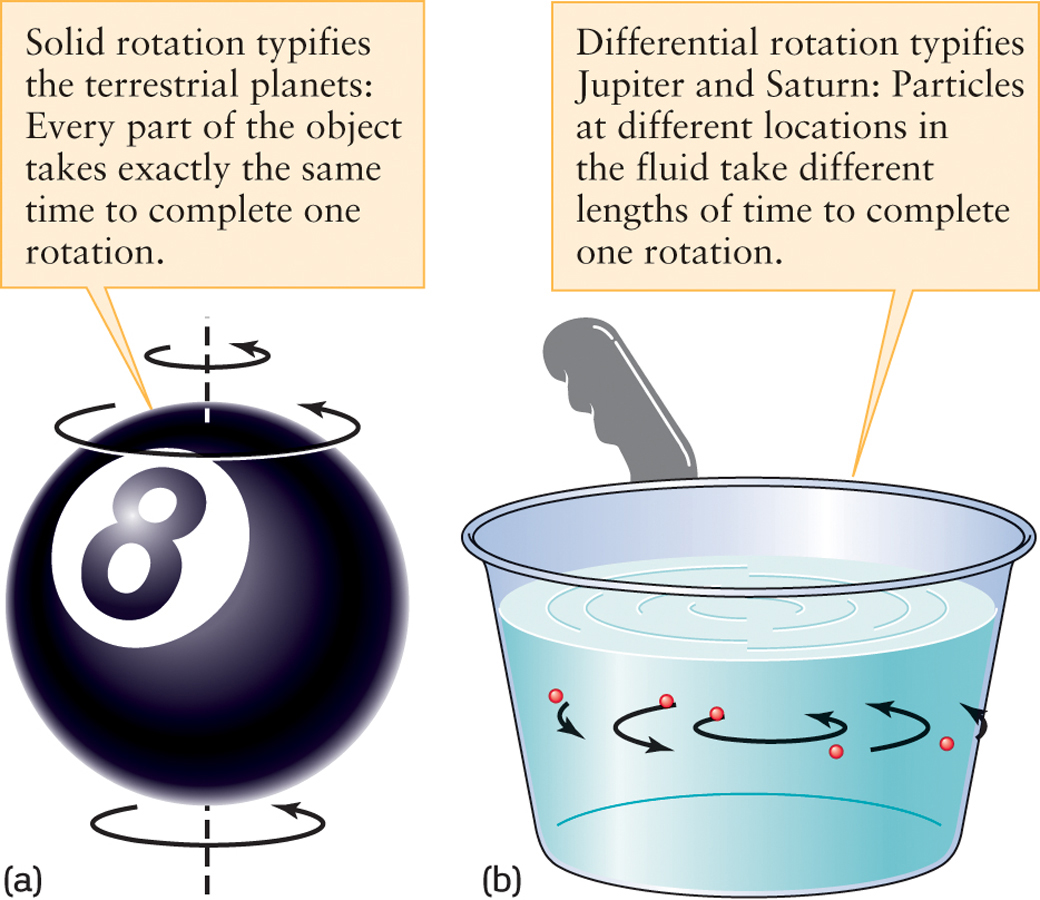
You can see this kind of rotation, called differential rotation, in the kitchen. As you stir the water in a pot, different parts of the liquid take different amounts of time to make one “rotation” around the center of the pot (Figure 7-2b). Differential rotation shows that neither Jupiter nor Saturn can be solid throughout their volumes: They must be at least partially fluid, like water in a pot. But, just what are these giant planets made of?
Question
ConceptCheck 7-1: Will Jupiter’s rocky moons, such as Ganymede, exhibit differential rotation?
The Compositions of Jupiter and Saturn
If Jupiter and Saturn have partially fluid interiors, they cannot be made of the rocky materials that constitute the terrestrial planets. An important clue to the compositions of Jupiter and Saturn is their average densities, which are only 1326 kg/m3 for Jupiter and 687 kg/m3 for Saturn. (By comparison, Earth’s average density is 5515 kg/m3.) The only way to account for such giant planets having such low densities is to assume that Jupiter and Saturn are composed mostly of hydrogen and helium atoms—the two lightest elements in the universe—held together by their mutual gravitational attraction to form a planet. This chemical composition is quite similar to the chemical composition of our Sun, and of many distant stars as well.
After centuries of speculation, the presence of helium on Jupiter and Saturn was finally confirmed in the 1970s and 1980s, when spacecraft first flew past these planets and measured their hydrogen spectra in detail. Today we know that the chemical composition of Jupiter’s atmosphere is 86.2% hydrogen molecules, 13.6% helium atoms, and 0.2% methane, ammonia, water vapor, and other gases. The percentages in terms of mass are somewhat different because a helium atom is twice as massive as a hydrogen molecule. Hence, by mass, Jupiter’s atmosphere is approximately 75% hydrogen, 24% helium, and 1% other substances, quite similar to that of the Sun. It is estimated that the breakdown by mass of the planet as a whole (atmosphere plus interior) is approximately 71% hydrogen, 24% helium, and 5% heavier elements.
Data from Earth-based telescopes and spacecraft show that, unlike Jupiter, the atmosphere of Saturn has far less helium than astronomers initially suspected. Its chemical composition is 96.3% hydrogen molecules, 3.3% helium, and 0.4% other substances (by mass, 92% hydrogen, 6% helium, and 2% other substances). This is a puzzle because Jupiter and Saturn are thought to have formed in similar ways from the gases of the solar nebula, and so both planets (and the Sun) should have essentially the same abundances of hydrogen and helium. So where did Saturn’s helium go?
170
The giants Jupiter and Saturn are composed of hydrogen and helium gas surrounding small, Earth-sized rocky cores.
Jupiter and Saturn are thought to have large rocky cores, but they are different. The explanation as to the surprising lack of helium may be simply that Saturn is slightly smaller than Jupiter, and as a result Saturn would have cooled more rapidly. This cooling would have triggered a process analogous to the way rain develops here on Earth. When the air is cool enough, humidity in Earth’s atmosphere condenses into raindrops that fall to the ground. On Saturn, however, it is droplets of liquid helium that condense within the planet’s cold, hydrogen-rich outer layers. In this scenario, helium is deficient in Saturn’s upper atmosphere simply because it has fallen farther down into the planet. By contrast, Jupiter’s helium has not rained out because its upper atmosphere is warmer and the helium does not form droplets.
ANALOGY
An analogy to helium “rainfall” within Saturn is what happens when you try to sweeten tea by adding sugar. If the tea is cold, the sugar does not dissolve well and tends to sink to the bottom of the glass even if you stir the tea with a spoon. But if the tea is hot, the sugar dissolves with only a little stirring. In the same way, it is thought that the descending helium droplets once again dissolve in hydrogen when they reach the warmer depths of Saturn’s interior.
In this scenario, Jupiter and Saturn both have about the same overall chemical composition. But Saturn’s smaller mass, less than a third that of Jupiter, means that there is less gravitational force tending to compress its hydrogen and helium. This explains why Saturn’s density is only about half that of Jupiter, and is in fact the lowest of any planet in the solar system.
CAUTION
Because Jupiter and Saturn are almost entirely hydrogen and helium, it would be impossible to land a spacecraft on either planet (Figure 7-3). An astronaut foolish enough to try would notice the hydrogen and helium around the spacecraft becoming denser, the temperature rising, and the pressure increasing as the spacecraft descended. But the hydrogen and helium would never solidify into a surface on which the spacecraft could touch down. Long before reaching the planet’s rocky core, the pressure of the hydrogen and helium would reach such unimaginably high levels that any spacecraft, even one made of the strongest known materials, would be crushed.
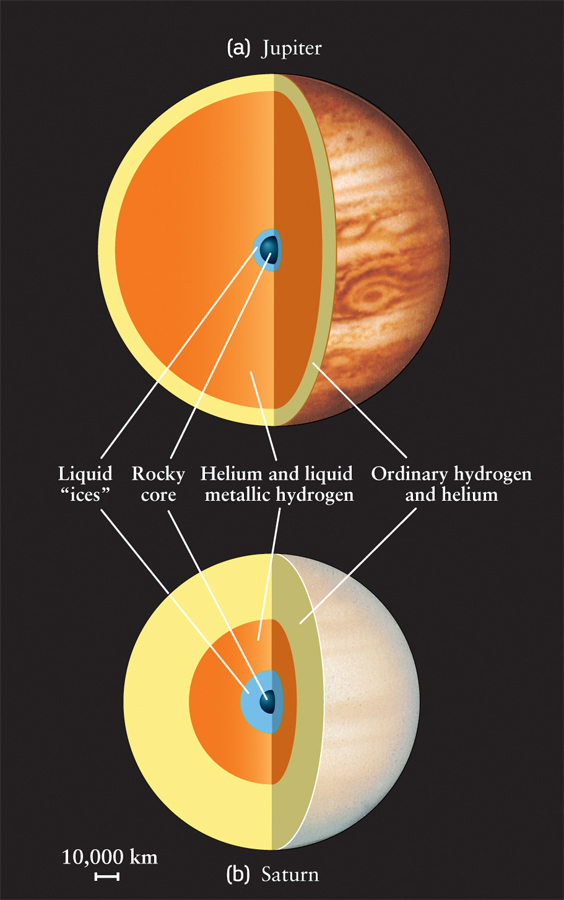
One might consider that developing this detailed an understanding is nothing short of amazing, considering that Jupiter and Saturn are never closer than 300 million mi (500 million km) and 600 million mi (1 billion km) away from Earth, respectively. We can learn even more when we study them at close range.
Question
ConceptCheck 7-2: If Jupiter and Saturn formed with nearly the same chemical composition, why might Jupiter be observed to have more helium than Saturn?
Robotic Spacecraft Discoveries of Jupiter and Saturn’s Atmospheres
Most of our detailed understanding of Jupiter and Saturn comes from a series of robotic spacecraft that have examined these remarkable planets at close range. They found striking evidence of stable, large-scale weather patterns in both planets’ atmospheres, as well as evidence of dynamic changes on smaller scales.
The first of several spacecraft to visit Jupiter and Saturn each made a single flyby of the planet. Pioneer 10 flew past Jupiter in December 1973; it was followed a year later by the nearly identical Pioneer 11, which went on to make the first-ever flyby of Saturn in 1979. Also in 1979, another pair of spacecraft, Voyager 1 and Voyager 2, sailed past Jupiter. These spacecraft sent back spectacular close-up color pictures of Jupiter’s dynamic atmosphere. Both Voyagers subsequently flew past Saturn.
171
The first spacecraft to go into Jupiter orbit was Galileo, which carried out an extensive program of observations from 1995 to 2003. The Cassini spacecraft went into orbit around Saturn in 2004. A cooperative project of NASA, the European Space Agency, and the Italian Space Agency, this spacecraft is named for the astronomer Gian Domenico Cassini. On the way to its destination it viewed Jupiter at close range, recording detailed images such as Figure 7-1a and later the images of Saturn that open this chapter.
Over the years, astronomers carefully studying Jupiter from Earth, Earth-orbiting telescopes, and spacecraft have reported many long-term variations in the darkness and size of Jupiter’s bands (Figure 7-4). Of particular interest are changes in Jupiter’s notorious Great Red Spot, which measures 25,000 mi by 8500 mi (40,000 km by 14,000 km)—so large that three Earths could fit side by side across it. At other times (as in 1976 and 1977), the spot almost faded from view. During the Voyager flybys of 1979, the Great Red Spot was comparable in size to Earth (Figure 7-5).
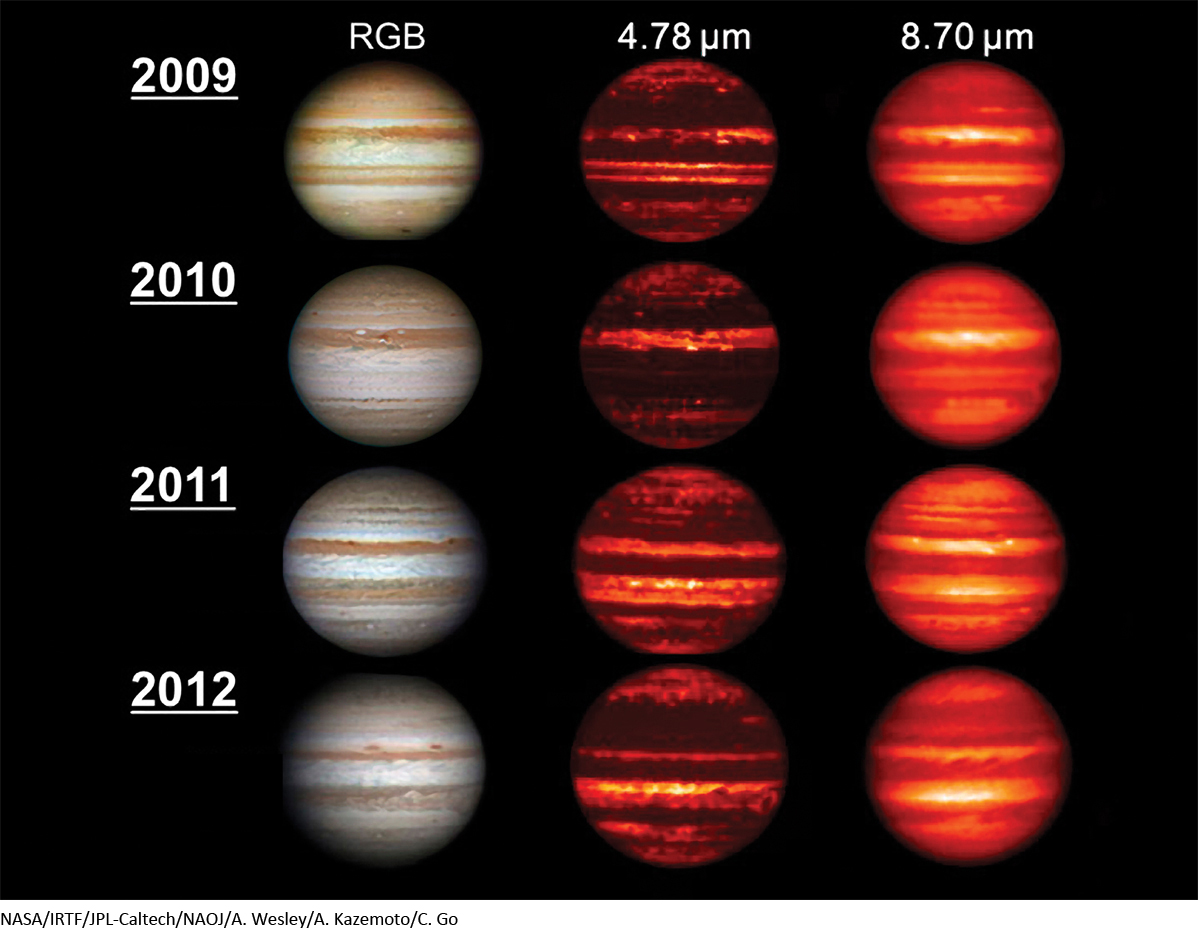

Other persistent features in Jupiter’s atmosphere are the white ovals. Several white ovals are visible in Figure 7-5. As in the Great Red Spot, wind flow in white ovals is counterclockwise. White ovals are also apparently long-lived; Earth-based observers have reported seeing them in the same location since 1938.
Most of the white ovals are observed in Jupiter’s southern hemisphere, whereas brown ovals are more common in Jupiter’s northern hemisphere. Brown ovals, most easily seen in the 2012 image, appear dark in visible light, but they appear bright in the infrared images shown along the right-hand side of Figure 7-5. For this reason, brown ovals are understood to be holes in Jupiter’s cloud cover. They permit us to see into the depths of the Jovian atmosphere, where the temperature is higher and the atmosphere emits infrared light more strongly. White ovals, by contrast, have relatively low temperatures. They are areas with cold, high-altitude clouds that block our view of the lower levels of the atmosphere. What is perhaps even more curious is that these white ovals can merge and form even larger features.
Question
ConceptCheck 7-3: Besides color, what is the difference between Jupiter’s white ovals and brown ovals?
172
Jupiter and Saturn’s Cloud Layers
If white ovals obscure warmer cloud layers below, you might wonder just how many layers exist. From spectroscopic observations and calculations of atmospheric temperature and pressure, scientists conclude that both Jupiter and Saturn have three main cloud layers of differing chemical composition. The uppermost cloud layer is composed of crystals of frozen ammonia. Deeper in the atmosphere, ammonia (NH3) and hydrogen sulfide (H2S)—a compound of hydrogen and sulfur—combine to produce ammonium hydrosulfide (NH4SH) crystals. At even greater depths, the clouds are composed of crystals of frozen water.
Jupiter’s strong surface gravity compresses these cloud layers into a region just 50 mi (80 km) deep in the planet’s upper atmosphere (Figure 7-6a). But Saturn has a smaller mass and hence weaker surface gravity, so the atmosphere is less compressed and the same three cloud layers are spread out over a range of nearly 175 mi (280 km) (Figure 7-6b). The colors of Saturn’s clouds are less dramatic than Jupiter’s (see Figure 7-1a) because deeper cloud layers are partially obscured by the hazy atmosphere above them.
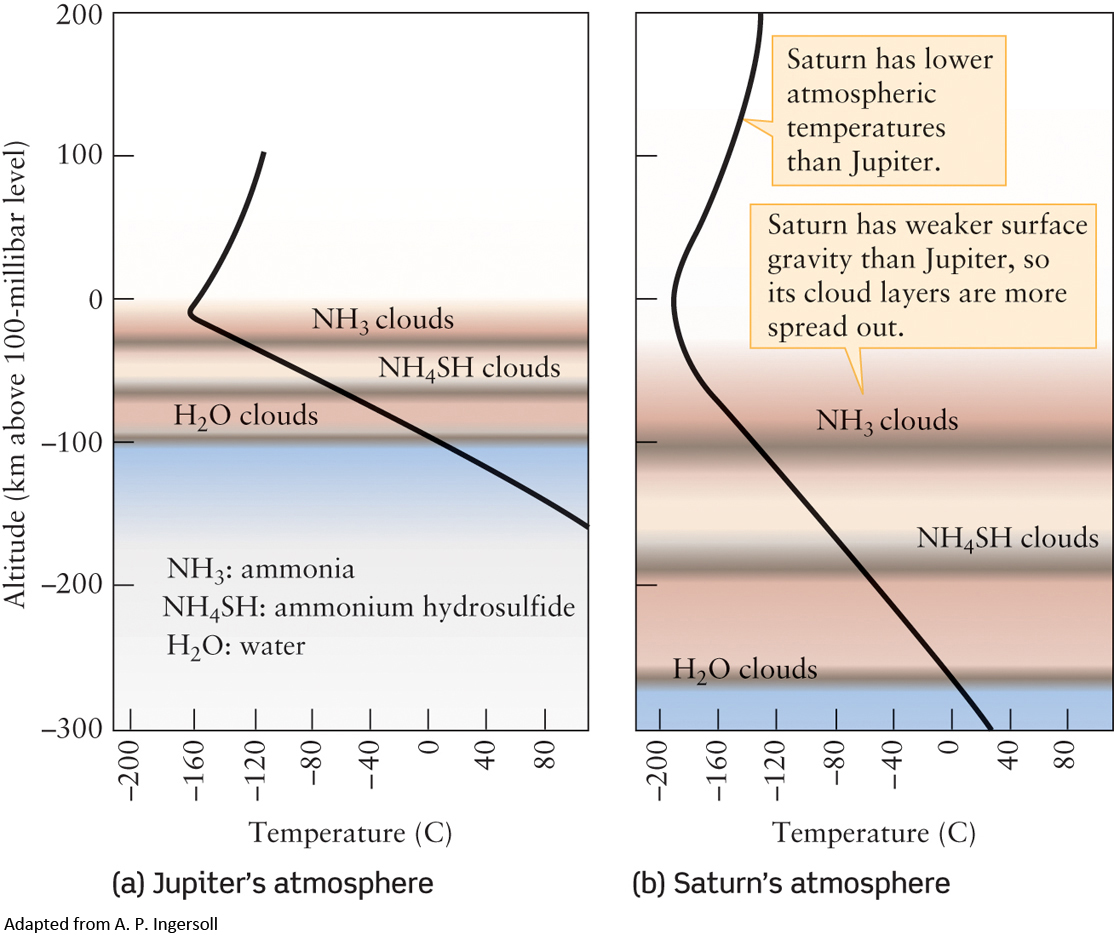
The colors of clouds on Jupiter and Saturn depend on the composition and temperatures of the clouds and, therefore, on the depth of the clouds within the atmosphere. Brown clouds are the warmest and are thus the deepest layers that we can see. Whitish clouds form the next layer up, followed by red clouds in the highest layer. The whitish zones on each planet are therefore somewhat higher than the brownish belts, while the red clouds in Jupiter’s Great Red Spot are among the highest found anywhere on that planet.
By observing Jupiter’s and Saturn’s cloud layers from a distance, we have been able to learn a great deal about the atmospheres beneath the clouds. But there is no substitute for making measurements on site, and for many years scientists planned to send a spacecraft to explore deep into Jupiter’s atmosphere. While still 50.66 million mi (81.52 million km) from Jupiter, the Galileo spacecraft released the Galileo Probe, a cone-shaped body about the size of an office desk. While Galileo itself later fired its rockets to place itself into an orbit around Jupiter, the Galileo Probe continued on a course that led it, on December 7, 1995, to a point in Jupiter’s clouds just north of the planet’s equator.
A heat shield protected the Galileo Probe as air friction slowed its descent speed from 106,000 mi/h (171,000 km/h) to 25 mi/h (40 km/h) in just 3 minutes. The spacecraft then deployed a parachute and floated down through the atmosphere (Figure 7-7). For the next hour, the probe observed its surroundings and radioed its findings back to the main Galileo spacecraft, which in turn radioed them to Earth. The mission ceased at a point some 120 mi (200 km) below Jupiter’s upper cloud layer, where the tremendous pressure (24 atm) and high temperature (305°F = 152°C) finally overwhelmed and crushed the probe’s electronics.
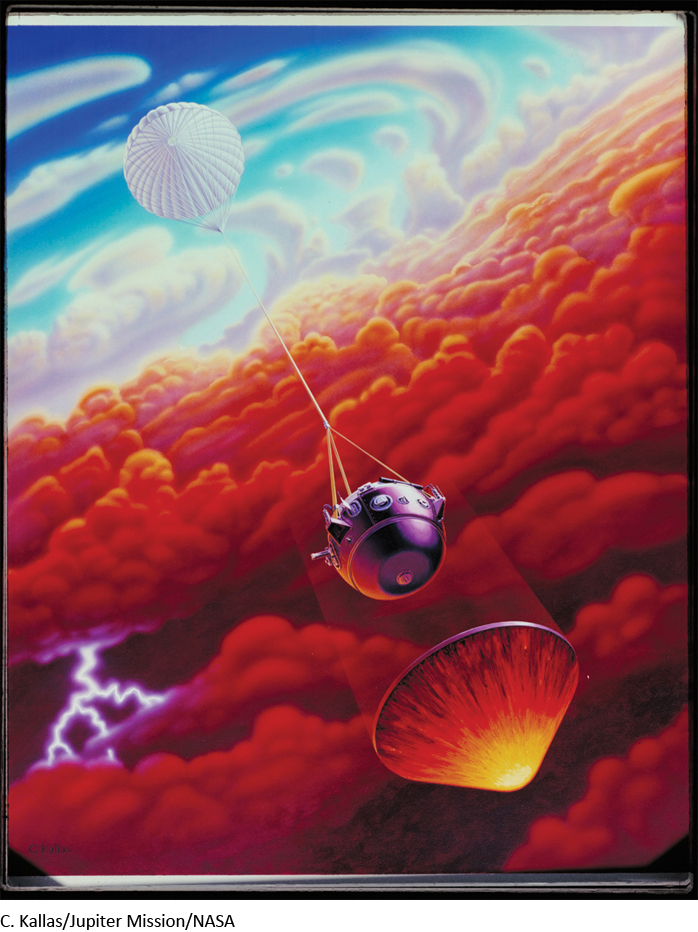
173
Although the Galileo Probe did not have a camera, it did carry a variety of instruments that made several new discoveries. A radio-emissions detector found evidence for lightning discharges that, while less frequent than on Earth, are individually much stronger than lightning bolts in our atmosphere. Other measurements showed that Jupiter’s winds, which are brisk in the atmosphere above the clouds, are even stronger beneath the clouds: The Galileo Probe measured a nearly constant wind speed of 400 mi/h (650 km/h) throughout its descent. This shows convincingly that the energy source for the winds is from Jupiter’s own interior heat. If the winds were driven primarily by solar heating, as is the case on Earth, the wind speed would have decreased with increasing depth. A central purpose of the Galileo Probe mission was to test a three-layer cloud model depicted in Figure 7-6a by making direct measurements of Jupiter’s clouds. But the probe saw only traces of the NH3 and NH4SH cloud layers and found no sign at all of the low-lying water clouds. One explanation of this surprising result is that the probe by sheer chance may have entered an unusually warm and cloud-free part of Jupiter’s atmosphere. Indeed, observations from Earth showed strong infrared emission from the probe entry site, as would be expected where a break in the cloud cover allows a view of Jupiter’s warm interior (Figure 7-8).

Another surprising and potentially important result from the Galileo Probe concerns three elements, argon (Ar), krypton (Kr), and xenon (Xe). These elements are relatively unique in that they do not combine with other atoms to form molecules. All three of these elements appear only in tiny amounts in Earth’s atmosphere and in the Sun, and so they must also have been present in the original solar nebula. But the Galileo Probe found that argon, krypton, and xenon are about 3 times as abundant in Jupiter’s atmosphere as in the Sun’s. If these elements were incorporated into Jupiter directly from the gases of the solar nebula, they should be equally as abundant in Jupiter as in the Sun. So, the excess amounts of argon, krypton, and xenon must have entered Jupiter in the form of solid planetesimals, just as did carbon, nitrogen, and sulfur.
Jupiter and Saturn are extremely large planets orbiting far from other planets, but they are not the only gaseous planets in the outer solar system. As we look farther into the distant outer solar system, where temperatures are even lower being so far from our Sun, one wonders if the other gaseous planets are similar or different.
Question
ConceptCheck 7-4: Why might Jupiter’s cloud layers be more compressed than Saturn’s?